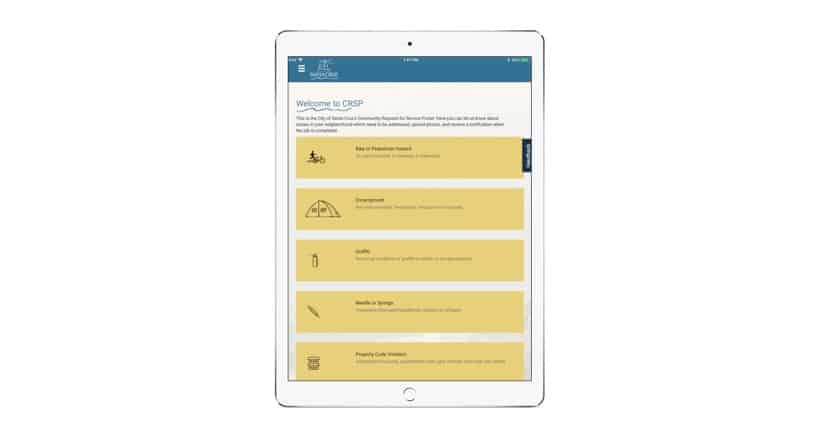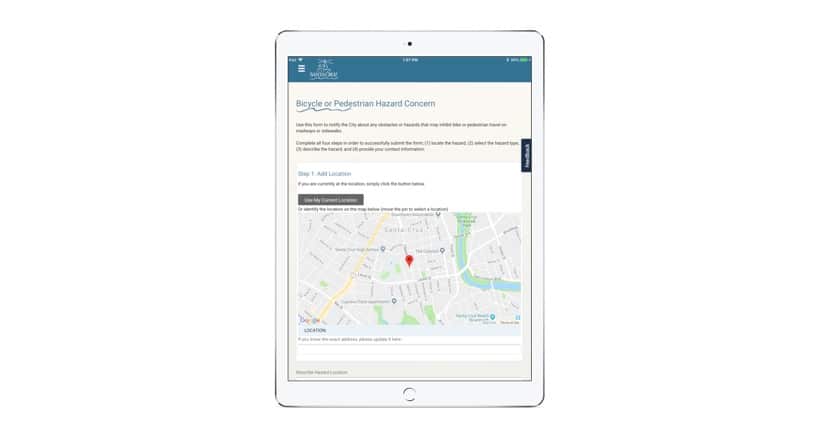In today’s maker profile, we speak with Alex Semplinkski, a business systems analyst for the City of Santa Cruz. Using Mendix, Alex has helped develop a service request portal for the community members of the City of Santa Cruz. Read how Alex learned how to develop with Mendix and built a tool he considers revolutionary for the municipality.
What’s your professional background. Do you have any prior programming experience?
I kind of fell into computer programming. I went to college for geophysics, which is a theoretical science, but it requires the use of computers to manipulate and apply physics problems to the large-scale planets. That got me into the logic behind computer programming.
I got an internship and fell into this role of process improvement, which inherently necessitated the use of programming. I knew Python, but I’d never really built an application with it. I kept learning these small parts of computer elements: networking protocols or application logic. Then I kept building slower and slower. And before Mendix, I was introduced to Salesforce, which got me into the end-to-end spectrum of process development within an organization.
What kind of problems were you solving?
At my old company, we built carts and robots that went to hospitals and provided telehealth services, but our salespeople either sold the units outright or they leased them. This precipitated into five situations for end-of-life or end-of-lease, and these units had to come back. Returns are historically one of the most painful processes for any business, especially when we’re talking about 150-grand units that take four-by-four space in a shipping container. It’s a lot of liability, a lot of checks and balances have to be filled out. The as-is process—when I was there—was that our sales would get a prompt from the customer saying, “Our lease is up. We’re going to send this back.”
Our salespeople would alert Sales Administration, who would fill out a form and then Sales Administration would email that form over to Operations, who would probably route that form to Purchasing, who would get another form and then they would email that form over to Shipping/Receiving to now get shipping quotes. Shipping would fill out another form; they’d arrange the shipping and then once it came in, they’d fill out another form and then possibly get it over to Manufacturing, Inspection and Q/A. After all that, they’d try to daisy chain it back, so that everyone has visibility of the process. But it’s a terrible process. There was no transparency; there’s a lot of room for error.
At the time we were using Salesforce, and I hadn’t had much exposure, except for basic administrative tasks. I had just been transferred from Shipping/Receiving working on two to three hours of shipping/receiving actions and then the rest of the time was spent on general improvement, but I was transferred to the Research Department because the company had obviously seen there was room for improvement. So, I went to my boss and asked him, “Hey, can you give me two weeks; I can get you a proof of concept here.” Within that two weeks, I taught myself the basics of developing in Salesforce and created a proof of concept for the simplest procedure. If I had known Salesforce, I would have developed a more complicated procedure and shown the value.
What was your initial reaction to Mendix? How would you compare using it to Salesforce?
For the City of Santa Cruz, Mendix was a great tool to use to start from scratch. Salesforce starts as a CRM, and then you adapt processes to it. Whereas with Mendix, you build the application how you want it to fit your business requirements and your functional requirements. I think that works great for a city because we are—maybe not inherently—a service provider. For the Community Request for Service portal that we built, it’s nice to go in and see our existing processes: What do people want? What on our website gets the most hits? Then we can develop a way to intake these processes and route them to the correct department. It was good to start off with a clean slate. As a local government, we are historically unable to change. Having this clean slate with Mendix is a great step forward.
Salesforce is supposed to do customer relationship management. Whereas with Mendix, you can say, “OK, well what is our problem? Let’s figure out the best way to solve that problem.” You can do that without the initial constraints of it being a CRM system.
What steps did you take to learn and start working with Mendix?
I went to your site—that’s usually my initial research point for anything—and I saw that you had a developer program. I did the training and it took about six hours. It was a good initial experience. From there, it seemed pretty intuitive to me, but I’m also very technically inclined, especially when it comes to application interfaces.
What was the first problem that you worked on using Mendix?
Our first problem was building a portal for citizens to submit requests for service, and then have those services routed to the correct city division, department, employee—all of the above. For example, we can take in a property code violation and send it to our land management system and have our code violation techs deal with it appropriately. We can get a graffiti request, see if it’s offensive or not, and then we could go to our economic development, who does the routing. We’re currently building an API to deal with contracted graffiti cleaners, who we can send requests to and they can deal with it as they see fit.
We’ve got a couple others, and I’m sure we’re going to have more in the future. It’s pretty revolutionary for a small municipality like us to be able to do this kind of stuff.


Mendix allows us to develop at a great pace, with minimal resources, which is kind of the sticking point, especially for municipal IT departments. It’s hard to get a developer and pay them 120 grand. That’s unfeasible for a municipality.
How has Mendix changed the way that you work?
In the past six months, I’ve only been using Mendix for development, so that’s an immediate change in my work. Mendix has also changed the pace of development. It’s changed the problems that I deal with. The change of how we [the City of Santa Cruz IT team] work has definitely been a pain point for the City of Santa Cruz, but I don’t think that’s a bad thing. I think it’s a step in the right direction.
At the City of Santa Cruz, we’re not a build shop. We look for out-of-box applications to solve our problems. This comes out of the monolithic era of software applications, and it’s antiquated, and it’s just not how the landscape of technology is moving forward. It’s moving to microservices.
Before Mendix, it was about configuring applications to see how it best fit our business process. Whereas now, it’s more like: “We have our business process, let’s build to it; let’s make this so that we can have as little friction between each touch point and each form that we can.” It’s really revolutionary for a municipality like us. I really can’t stress that enough because it just allows flexibility on a whole new scale.
Last question: Do you like pizza? If so, what is your favorite type of pizza?
Of course I like pizza. If we’re going New York Style—I’m a simple pepperoni and onion guy.

